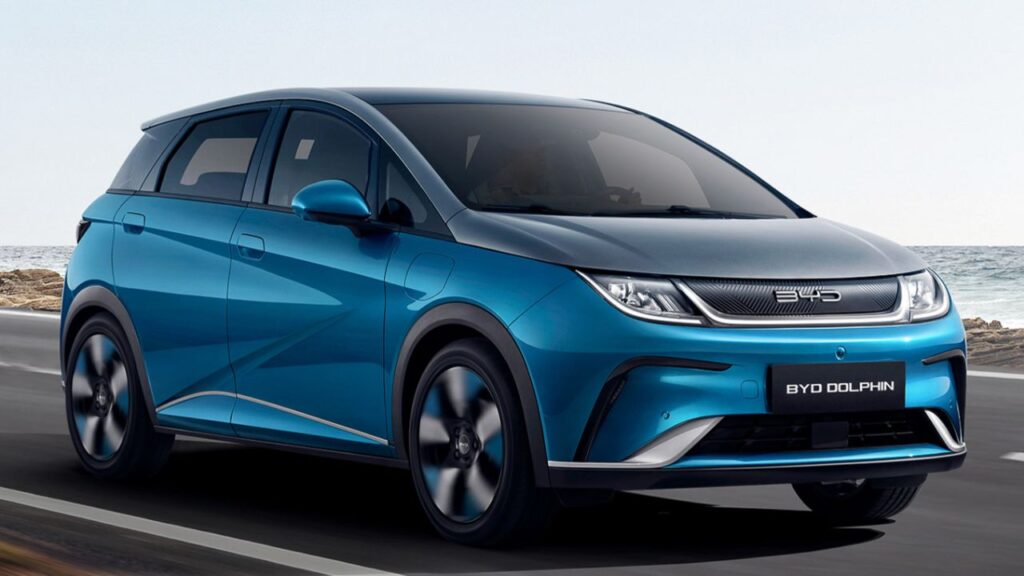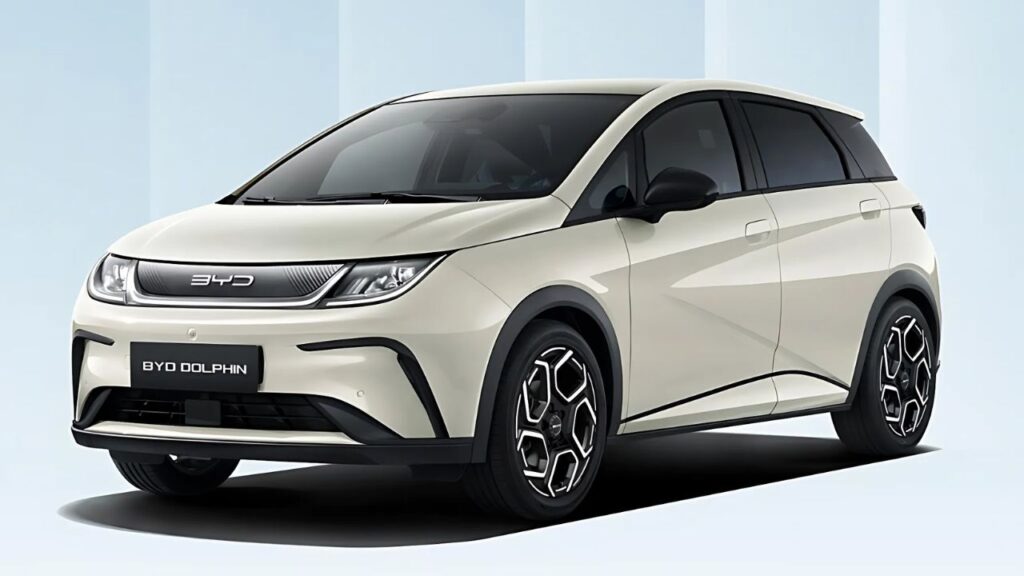The electric vehicle landscape is shifting dramatically as Chinese automaker BYD prepares to launch its most affordable offering yet. The BYD Dolphin 2025 represents a significant step forward in making electric mobility accessible to everyday drivers.
This compact electric hatchback promises to shake up the budget EV segment currently dominated by models like the MG4. With competitive pricing and impressive specifications, the Dolphin could change how Australians think about electric car ownership.

Design Philosophy: Simplicity Meets Functionality
BYD has taken a refreshingly honest approach with the Dolphin’s design language. The exterior features clean lines and practical proportions that prioritize efficiency over flashiness.
The front fascia showcases a closed-off grille typical of electric vehicles, complemented by sleek LED headlights. Body cladding around the wheel arches gives the Dolphin a slightly rugged appearance while maintaining its urban-friendly dimensions.
Interior Space Maximization
Step inside, and you’ll discover BYD’s clever packaging solutions at work. The cabin feels surprisingly spacious for a vehicle in this price bracket, thanks to the flat floor design enabled by the electric drivetrain.
Rear passengers benefit from generous legroom and headroom. The boot space, while not enormous, offers practical storage for daily needs and weekend getaways.
Technology Integration
The dashboard centers around a rotating touchscreen infotainment system that can switch between portrait and landscape orientations. This feature, borrowed from BYD’s premium models, brings high-tech functionality to the affordable segment.
Apple CarPlay and Android Auto come standard, ensuring seamless smartphone integration. The interface responds quickly to inputs, avoiding the laggy performance that plagues some budget vehicle systems.
Performance Specifications: Power Meets Efficiency
Under the hood, the Dolphin houses a single electric motor driving the front wheels. The powertrain delivers adequate performance for city driving and highway cruising without feeling underpowered.
Acceleration from 0-100 km/h takes approximately 10.9 seconds, which positions it competitively against traditional combustion engine vehicles in the same price range. The instant torque delivery characteristic of electric motors makes the Dolphin feel more responsive than these figures might suggest.
Battery Technology and Range
BYD’s Blade Battery technology powers the Dolphin, offering improved safety and longevity compared to traditional lithium-ion cells. The battery pack provides an estimated range of up to 340 kilometers on a single charge under WLTP testing conditions.
Real-world driving typically yields slightly lower figures, particularly in challenging weather conditions. However, this range suits most Australian commuting patterns and weekend driving needs perfectly.
Charging Capabilities
The Dolphin supports both AC and DC charging protocols, making it compatible with Australia’s growing charging infrastructure. AC charging at home or work takes approximately 6-8 hours using a standard 7kW wallbox.
DC fast charging can replenish the battery from 10% to 80% in roughly 40 minutes when using compatible high-speed chargers. This charging speed makes longer journeys more practical for adventurous owners.
Comparing Against the MG4: David vs Goliath
The MG4 has established itself as Australia’s go-to affordable electric vehicle, but the Dolphin brings fresh competition to this space. Both vehicles target similar buyers but take different approaches to achieving their goals.
Pricing represents the most significant battleground between these competitors. The Dolphin’s expected starting price could undercut the MG4 by several thousand dollars while offering comparable features and performance.
Feature Comparison
Safety equipment forms a crucial differentiator in this segment, where buyers expect maximum value for their investment. The Dolphin comes equipped with autonomous emergency braking, lane departure warning, and adaptive cruise control as standard features.
Build quality appears solid based on international reviews, though long-term reliability data remains limited. BYD’s growing global presence and expanding service network should address potential concerns about parts availability and maintenance support.
Driving Experience Differences
Road testing reveals subtle but important differences in how these vehicles behave on Australian roads. The Dolphin’s suspension tuning favors comfort over sportiness, making it well-suited to urban commuting and family duties.
Steering feel provides adequate feedback without being overly heavy or artificial. The regenerative braking system offers multiple adjustment levels, allowing drivers to customize the one-pedal driving experience to their preferences.
Market Positioning and Target Audience
BYD positions the Dolphin squarely at first-time EV buyers who want electric mobility without premium pricing. This strategy acknowledges that many Australians remain hesitant about making the switch to electric vehicles due to cost concerns.
Young families represent a key target demographic, attracted by the combination of practicality, efficiency, and modern technology. Empty nesters downsizing from larger vehicles also find appeal in the Dolphin’s compact dimensions and low running costs.
Urban vs Rural Suitability
City dwellers will appreciate the Dolphin’s compact size and silent operation, making it ideal for navigating congested streets and residential areas. Parking in tight spaces becomes significantly easier thanks to the vehicle’s manageable dimensions.
Rural buyers face more challenges, primarily related to charging infrastructure limitations. However, the Dolphin’s range capabilities handle most regional commuting requirements when combined with home charging solutions.
Total Cost of Ownership
Electric vehicles typically offer lower operating costs compared to petrol equivalents, and the Dolphin follows this trend. Electricity costs for charging remain significantly lower than fuel expenses, even accounting for recent energy price increases.
Maintenance requirements are minimal, with no oil changes, timing belts, or complex engine components requiring regular attention. Brake pads last longer due to regenerative braking, further reducing ongoing expenses.
Safety and Reliability Considerations
BYD has invested heavily in safety testing and certification processes to meet Australian Design Rules and ANCAP requirements. The Dolphin’s structure incorporates high-strength steel and advanced airbag systems to protect occupants in various collision scenarios.
Electronic stability control, traction control, and anti-lock braking systems come standard across all trim levels. These safety features work together to maintain vehicle stability in challenging driving conditions.
Battery Safety Features
The Blade Battery technology includes multiple safety systems to prevent thermal runaway and other potentially dangerous situations. Temperature monitoring, voltage regulation, and impact protection systems work continuously to ensure safe operation.
Fire suppression systems within the battery pack provide additional protection, addressing common concerns about electric vehicle safety in accident scenarios. BYD’s testing demonstrates the battery’s ability to withstand nail penetration and other extreme conditions.
Service Network Development
BYD continues expanding its Australian service network to support growing vehicle sales. Authorized service centers are increasing in major metropolitan areas, with plans for regional expansion following market demand.
Training programs for technicians ensure proper maintenance and repair capabilities. Parts availability should improve as sales volumes increase, though some components may require longer lead times during the initial launch period.
Environmental Impact and Sustainability
The Dolphin’s environmental credentials extend beyond zero tailpipe emissions. BYD’s manufacturing processes increasingly incorporate renewable energy sources and sustainable materials wherever possible.
Battery recycling programs are being developed to handle end-of-life vehicles responsibly. These initiatives address growing concerns about the environmental impact of electric vehicle battery disposal.
Lifecycle Analysis
Independent studies suggest that electric vehicles like the Dolphin produce lower lifetime emissions compared to equivalent combustion engine vehicles. This advantage becomes more pronounced as Australia’s electricity grid incorporates increasing renewable energy sources.
Manufacturing emissions are typically higher for electric vehicles due to battery production, but this initial deficit is quickly offset through zero-emission operation. The crossover point usually occurs within 2-3 years of typical driving patterns.
Grid Integration Benefits
Vehicle-to-grid technology could eventually allow Dolphin owners to sell electricity back to the power grid during peak demand periods. While not available at launch, future software updates might enable this functionality.
Smart charging capabilities help optimize charging times to take advantage of off-peak electricity rates and renewable energy availability. These features reduce both costs and environmental impact for conscientious owners.
Future Outlook and Market Impact

The Dolphin’s arrival signals BYD’s serious commitment to the Australian market and could accelerate electric vehicle adoption among budget-conscious consumers. Success in this segment often determines broader market acceptance of new technologies.
Competition benefits consumers through improved features, better pricing, and expanded choice. The Dolphin’s challenge to MG4’s dominance should drive innovation and value improvements across the affordable EV segment.
Technology Evolution
Future model updates will likely bring improved battery chemistry, extended range, and enhanced connectivity features. Over-the-air updates could add new functionality without requiring hardware changes.
Autonomous driving capabilities may eventually filter down to affordable models like the Dolphin, though regulatory approval and cost considerations will determine the timeline for such features.
Frequently Asked Questions
Q1: What is the expected price range for the BYD Dolphin 2025?
The BYD Dolphin 2025 is expected to start around $35,000-$38,000 before on-road costs, positioning it competitively against the MG4.
Q2: How long does it take to charge the BYD Dolphin?
Home charging takes 6-8 hours with a 7kW wallbox, while DC fast charging can reach 80% capacity in approximately 40 minutes.
Q3: What warranty coverage does BYD offer on the Dolphin?
BYD typically provides 6-year vehicle warranty and 8-year battery warranty, though specific Australian terms may vary at launch.
Also Read: MG Cyberster EV Roadster Priced at, 115K in Australia

